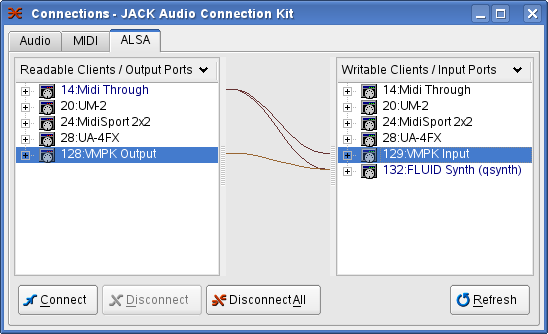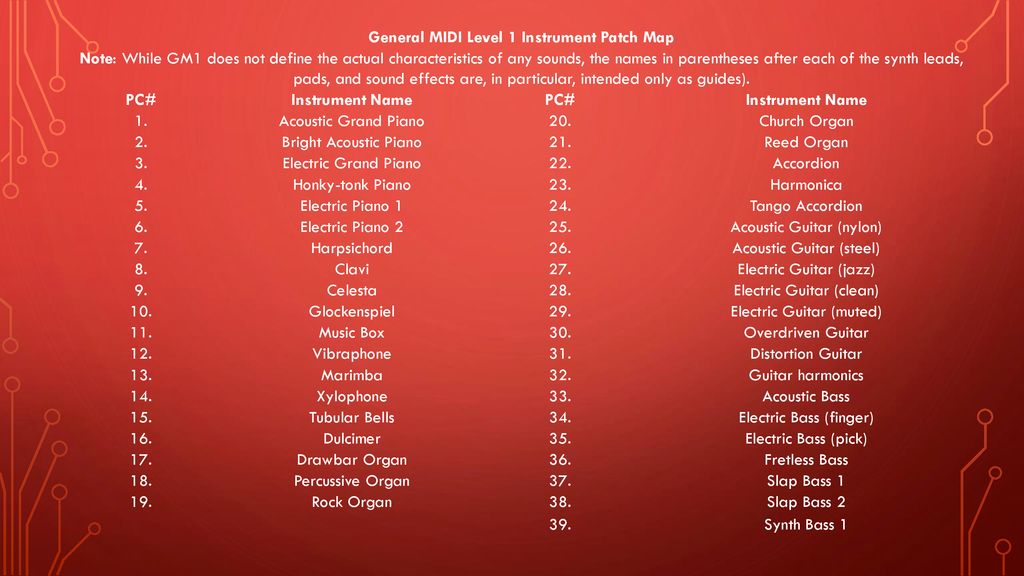There is not any program to generate MIDI maps, so you will have to edit a fileby hand (using your favorite text editor).

A Midi map is a text file that keeps all the needed translations there will bemade when playing music.
It consist of four sections: PATCHMAP,KEYMAP, CHANNELMAP andOPTIONS.Each section must appear only once.
The General MIDI Specification includes the definition of a General MIDI Sound Set (a patch map), a General MIDI Percussion map (mapping of percussion sounds to note numbers), and a set of General MIDI Performance capabilities (number of voices, types of MIDI messages recognized, etc.). A MIDI sequence which has been generated for use on a.
Instrument Patch Mapping The 128 instruments are arranged into 16 families. Note that the instrument numbers shown here (PC #) range from 1-128, though the actual value used in the MIDI. General MIDI Level 1 Instrument Patch Map The names of the instruments indicate what sort of sound will be heard when that instrument number is selected on the GM1 sound module. The General MIDI Level 1 instrument sounds are grouped by families. General MIDI Level 1 Instrument Patch Map Note: While GM1 does not define the actual characteristics of any sounds, the names in parentheses after each of the synth leads, pads, and sound effects are, in particular, intended only as guides). PC# Instrument Name PC# Instrument Name 1. Acoustic Grand Piano 65. Bright Acoustic Piano. General MIDI Note Number assignments. There were also deviances in regards to Note Number mapping. For example, some manufacturers mapped middle 'C' to MIDI Note Number 60. Others mapped it to Note Numbers 72 or 48. Some modules even had middle C mapped to various places in different patches, depending upon the instrument.
Midi Instruments Online

The general structure of a map file is an ini style file:
Each one of the four section names between square brackets starts the corresponding section. You can put comments by starting the line with a# character. Each section is a collection of severallines of key=value pairs.
Please, do not forget to send me your map file by email, so that futurereleases of KMid will include support for more non General Midicompliant keyboards.
This section is used to specify how patches are going to be mapped, fromGM to your keyboard specs. The general usage is:

Where N is the number that you keyboard needs toreceive to change the patch to the same that the GM standard does .
Please note that the left side of the equal sign is a symbolic key, so you can change the order of the lines and omit any of the 128 instruments.
The KEYMAP section is used to specify how percussion keys aregoing to be mapped. The usage is:
As with the PATCHMAP section, you can change the order of the lines, and omit any of them. Only the first four charactersof each key are taken into account.
Keymaps are only used to map keys in the percussion channel. Have alook at the distributed maps to see some examples.
This section can be used to map some channels to different ones. Forexample, if you want to swap the first and second channels, you caneasily do it within the CHANNELMAP section.
However it is more useful for keyboards that need the percussionchannel to be in a given channel (the GM standard use the channel 10,others use the channel 16 and others use channel 9).

Note that MIDI devices use 16 channels, so the CHANNELMAP section, has 16 lines, from 0 to 15 , as this one:
Where N is the channel which is mapped to theM channel.
The OPTIONS section has some general options that canbe very useful:

You can specify all options, only one, or none of them.
The PitchBenderRatio r value, has the ratio by whichpitch bender events will be multiplied. That is, when a MIDI file triesto send a pitch bender event with a n value, the realvalue that will be sent is n*(r/4096) (the4096 value is for not having to put decimal points inthe map file).
This is used because the GM standard says that when aMIDI keyboard receives a Pitch Bender event with a 4096 data value, itshould bend the note to a higher one , but some MIDI keyboards try tobend the initial note by two or more higher notes (even an octavehigher!) when they receive a 4096. This can be easily fixed by tryingdifferent values so that instead of sending a 4096, KMid sends theappropriate value.
When the MapExpressionToVolumeEvents option is set inthe map file, and a MIDI file try to send an expression event, KMid willsend a volume event which is understood by more non-GM keyboards, andwhich has a similar effect. There are many MIDI files which useexpression events to fade out at the end of a song, so if you feel thatmusic should be heard softer and softer, you can turn on this option andsee if this is what you need, because your MIDI synthesizer could beignoring the expression events because it does not understand them.
The ForceDrumsPatch option may be useful to always use the percussion patch on the percussion channel.
Table of Contents
Midi Instrument Number
Note - Using Offline Help
Note: If you prefer to always use offline Help, go to Edit > Preferences > File > Advanced in your Cakewalk software and select Always Use Offline Help.
If you are not connected to the internet, your Cakewalk software will default to showing offline help until an internet connection becomes available.